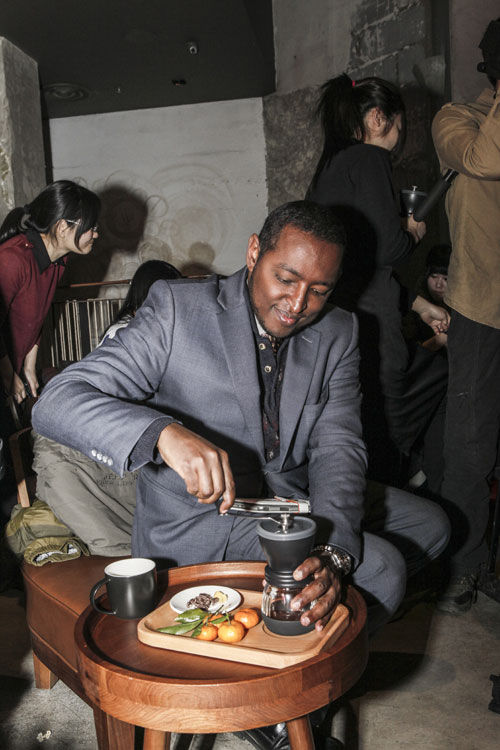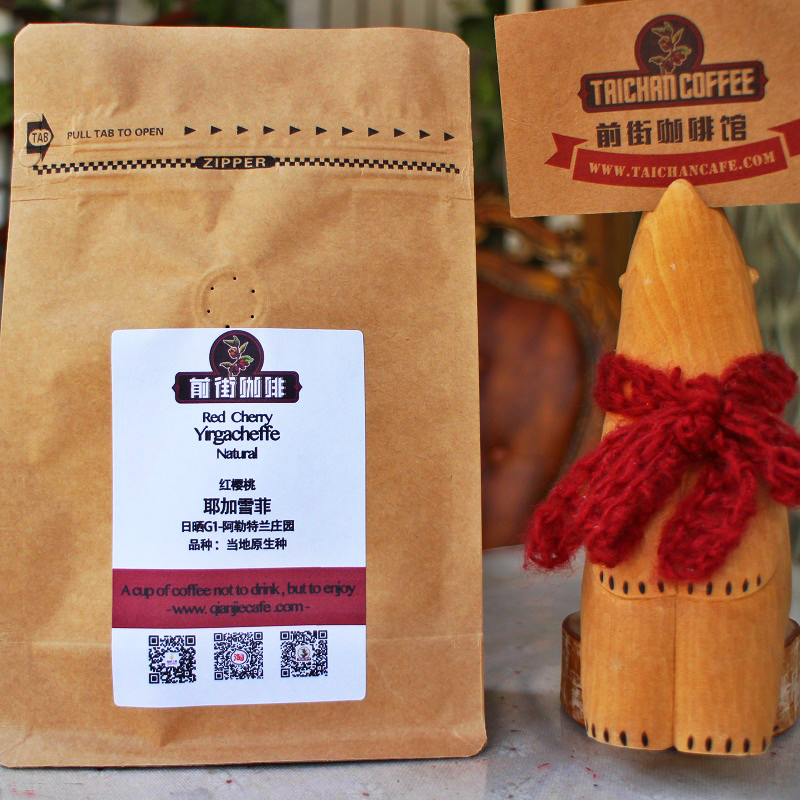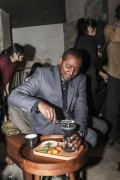How about Starbucks Ethiopian food? Starbucks launches Ethiopian moderately roasted coffee
Yega Xuefei is a small town in Ethiopia, 1700-2100 meters above sea level. It is located in the northwest of Sidamo Province. It is one of the highest coffee producing areas in Ethiopia and is synonymous with Ethiopian boutique coffee. Strictly speaking, Yega Xuefei is a by-product area of the Sidamo region of Ethiopia (Sidamo), which is independent because of its special flavor.
Recently, Starbucks Coffee has launched a brand new coffee-Ethiopian moderately roasted coffee. Ethiopia is the birthplace of coffee.
The new coffee, which adds 20 Starbucks core ingredients, 10 traditional and seasonal beans, has been fully available in Starbucks retail stores in the United States.
"We are very careful in choosing raw materials and using Starbucks' classic baking to create a unique flavor that is different from other Starbucks coffee," said Craig Russell, senior vice president of Starbucks Global Coffee. "We want to use this product to remember Ethiopia's rich coffee cultural heritage. We also want our customers to experience the unique flavor of coffee from the birthplace of coffee. "
The new Ethiopian coffee can be bought from Starbucks retailers and online stores with a suggested retail price of $13.95 per pound.

Ethiopia: where Coffee was born
Ethiopia is recognized as the birthplace of coffee and the birthplace of all kinds of coffee we taste today. it plays an important role in the history of coffee development. With respect and admiration for the birthplace of coffee and the long-standing heritage of coffee culture, Starbucks solemnly launched the unique "Ethiopian Coffee" in stores across the country a few days ago. From January 6 to 12, it launched "Ethiopian Coffee week" in various stores to provide customers with pure Starbucks coffee while leading customers to experience a wonderful and unique journey of Starbucks coffee culture.
Legend has it that in the sixth century AD, an Arab shepherd came to the Ethiopian grasslands for grazing. He found that sheep became extremely active after eating a local red fruit. The shepherd himself tasted some. He found these fruits not only sweet and delicious, but also refreshing after eating. It happened that a Muslim was passing by and brought this incredible red fruit back to share with other parishioners. In this way, this delicious fruit quickly spread. This is the legendary origin of coffee.
In Ethiopia, people are proud of coffee and regard it as a gift to give back to the world. To this day, many Ethiopian families still retain the ceremony of daily coffee celebrations, with the hostess of each family inviting her family and neighbors to have coffee more than once a day. In their view, this is a way to show friendship and respect. In the magical land of Ethiopia, coffee beans are filled with the unique smell of coffee beans, and the sound of "Buna-Buna Tetu" is heard from time to time. Such a scene makes people full of wonderful expectations for coffee.
Starbucks launches Ethiopian medium roasted coffee Starbucks Ethiopian coffee: blessings from the birthplace of coffee
If coffee is a gift from Ethiopia to the world, then Starbucks' latest Ethiopian coffee is an expression of Starbucks' respect for the birthplace of coffee as a coffee industry leader. It is Starbucks' commitment to the origin of coffee, the inheritance and development of coffee culture, and the New year's resolution that Starbucks brings to Chinese customers.
This special coffee is made of washed beans from Stammer and Lim, two famous coffee producing areas in Ethiopia. It is moderately roasted and has a soft and smooth taste with a hint of black cocoa, spice and sweet citrus. It is a very delicious and unique coffee, suitable for tasting with dark chocolate and citrus fruits.
When you come to Starbucks stores recently, customers will find that Starbucks friends like to say "Buna-Buna Tetu". This is what Ethiopians say when they invite guests to a coffee celebration, which means "have a cup of coffee". For hundreds of years, Ethiopians have been used to drinking coffee and having parties at the same time, sharing coffee delicacies with friends and relatives at home through daily coffee celebrations. With the mysterious and unique taste from the coffee shrine, Starbucks Ethiopian Coffee inspires people's enthusiasm and imagination about coffee and its place of origin. It is very suitable as a gift to family and friends. When the New year is approaching, we can experience the customs and human feelings of Ethiopia together, and feel the blessings from the birthplace of coffee.
Yejia Xuefei, nearly 2,000 meters above sea level, is one of the highest coffee producing areas in the world. It has been a wetland since ancient times. "Yirga" means "settle down" and "Cheffe" means "wetland". Lake Turkana, Lake Abaya and Lake Chamo bring abundant water vapor. The Rift Valley, represented by Misty valley, is foggy all the year round, like spring all the year round, with a gentle breeze, cool and humid, and thousands of coffee trees thrive, giving birth to the unique and unpredictable atmosphere of Yejia Xuefei's unique fragrance of flowers and fruits.
European monastic academics opened up a local coffee growing industry, which was later run by coffee communities or cooperatives in villages around the town. There are no special plantations here, and coffee trees are naturally scattered in the forest and countryside. During the harvest season, the Ethiopian Coffee Trading Company goes to town to buy coffee beans collected by farmers.
In addition to the small town of Yega Xuefei, it also includes three by-product areas such as Wenago, Kochere and Gelena/Abaya around it.
1. Planting system and environment the mountain stream village in the Yega Xuefei producing area is cool and foggy, like spring all the year round, with a gentle breeze in summer, cool but not hot, rain but not damp, and no cold damage in winter, which is the best environment for planting Arabica. There are no large coffee plantations. Coffee farmers mix coffee with other crops, usually under banana trees, to form a unique landscape.
2. The traditional way of solarization in Ethiopia is rough and smelly, which has been criticized by people. In 1959, the South American water washing method was introduced into the Yega Xuefei producing area. Most producing areas generally adopt the water washing treatment, that is, after the coffee fruit is peeled, the pectin layer is removed after fermentation and washing, and then dried. Since 2006, some coffee processing plants in some producing areas have adopted the exquisite elevated shed sun drying method, which invests in high-intensity human labor, which isolates the coffee fruit from contact with the ground and prevents the miscellaneous smell of soil in the process of sunlight. create an unusually clean fruit flavor. After more than two weeks of sun exposure, dark brown coffee fruits are professionally stored, waiting for the whole flavor to ripen. Before sale, the sun-dried cherry pulp and sheepskin are removed, and then the unripe beans and over-fermented beans are removed. Strict control greatly improves the quality of sun-dried beans.
3. Flavor and characteristics
Washed Yega Chuefei: it has a unique lemon flavor, refreshing jasmine flavor, as well as soft fruit acid and citrus flavor, fresh and bright taste.
Sun Yega Chuefei: with charming fruit acidity, clean fermented fruit sweet, elegant fruit wine, sweet finish.
4. The grading system of grade Ethiopian coffee is not based on the number of items, but on the proportion of defective beans in raw beans. Ethiopia launched the ECX boutique coffee trading grading system, and Q-Grader made the following grades through the evaluation of raw beans: washed Yega Xuefei is divided into Grade 1 and Grade 2, Sun Yega Xuefei is divided into Grade 1, Grade 3, Grade 4, Grade 5, and Grade 1 is the highest grade, that is, Yega Xuefei with the lowest defect rate and the best quality. This article is sorted out according to Han Huaizong's "Fine Coffee" and other contents of the Internet.
Name and introduction of Coffee Cooperative in Ethiopia
Sigiga Cooperative (1600-2500 m)
Production area: Gedeo-Kochere Kochel
Number of members: 1862
Land attribute: red brown soil
Certificate: Fair Trade Fair Trade, UTZ Sustainable cultivation, Organic Organic Coffee
Finchewan Cooperative (1450-2000 m)
Production area: Gedeo-Wenago vena fruit
Number of members: 1271
Land attribute: red brown soil
Certificate: Fair Trade Fair Trade, Organic Organic Coffee
Konga Conga Cooperative (1750-2300 m)
Production area: Gedeo- Yega Xuefei
Number of members: 1556
Land attribute: red brown soil
Certificate: Fair Trade Fair Trade, Organic Organic Coffee
Hafursa Cooperative (1750-2300 m)
Production area: Gedeo- Yega Xuefei
Number of members: 1975
Land attribute: red brown soil
Annual output of raw coffee beans: 798000 kg
Average farm size: up to 4 hectares with an annual yield of about 600 kg per hectare
The cooperative has a washing station.
Certificate: Fair Trade Fair Trade, Organic Organic Coffee
Resa Cooperative (1000-1400 m)
Production area: Gedeo-Wenago vena fruit
Number of members: 2719
Land attribute: red brown soil
Two sets of coffee processing equipment are available.
Certificate: Fair Trade Fair Trade, Organic Organic Coffee
Addis Katema Cooperative (1000-1400 m)
Production area: Gedeo-Wenago vena fruit
Number of members: 891
The cooperative has a washing station.
Land attribute: red brown soil
Certificate: Fair Trade Fair Trade, Organic Organic Coffee
Biloya Biloya Cooperative (1600-2500 m)
Production area: Gedeo-Kochere Kochel
Number of members: 1203
Land attribute: red brown soil
Provide two sets of coffee processing equipment
Certificate: Fair Trade Fair Trade, Organic Organic Coffee
Worka Waka Cooperative (1650-2700 m)
Production area: Gedeb
Number of members: 305
Land attribute: red brown soil
Annual output of raw coffee beans: 457000 kg
Average farm size: maximum 4 hectares, annual yield of about 699 kg per hectare
The cooperative has all the processing equipment.
Certificate: Fair Trade Fair Trade, Organic Organic Coffee
Koke Cook Cooperative (1750-2300 m)
Production area: Gedeo- Yega Xuefei
Number of members: 828
Land attribute: red brown soil
A set of processing equipment can be provided
Certificate: Fair Trade Fair Trade, UTZ Sustainable cultivation, Organic Organic Coffee
Hama Cooperative (1600-2500 m)
Production area: Gedeo-Kochere Kochel
Number of members: 1505
Land attribute: red brown soil
A set of processing equipment can be provided
Certificate: Fair Trade Fair Trade, Organic Organic Coffee
Chichu Cooperative (1410-2000 m)
Production area: Gedeo-Dila
Number of members: 1675
Land attribute: red brown soil
Average farm size: up to 4 hectares, with an annual yield of about 591 kg per hectare
A set of processing equipment can be provided
Certificate: Fair Trade Fair Trade, Organic Organic Coffee
Michile Cooperative (1410-2000 m)
Production area: Gedeo-Dila
Number of members: 1206
Land attribute: red brown soil
Average farm size: annual yield per hectare is about 592 kg
A set of processing equipment can be provided
Certificate: Fair Trade Fair Trade, UTZ Sustainable cultivation, Organic Organic Coffee
Hase Haro Cooperative (1450-2000 m)
Production area: Gedeo-Wenago vena fruit
Number of members: 1519
Land attribute: red brown soil
Average farm size: up to 4 hectares, with an annual yield of about 591 kg per hectare
A set of processing equipment can be provided
Certificate: Fair Trade Fair Trade, Organic Organic Coffee
Dumerso Dumeso Cooperative (1750-2300 m)
Production area: Gedeo- Yega Xuefei
Number of members: 246
Land attribute: red brown soil
Two sets of processing equipment can be provided.
Certificate: Fair Trade Fair Trade, Organic Organic Coffee
Tumticha Cooperative (1410-2000 m)
Production area: Gedeo- Yega Xuefei
Number of members: 960
Land attribute: red brown soil
Two sets of processing equipment can be provided.
Certificate: Fair Trade Fair Trade, Organic Organic Coffee
Aramo Cooperative (1750-2300 m) (90 + Clinique producing area)
Production area: Gedeo- Yega Xuefei
Number of members: 2254
Land attribute: red brown soil
Two sets of processing equipment can be provided.
Certificate: Fair Trade Fair Trade, Organic Organic Coffee
Edido Ediot Cooperative (1750-2300 m)
Production area: Gedeo- Yega Xuefei
Number of members: 1044
Land attribute: red brown soil
A set of processing equipment can be provided
Certificate: Fair Trade Fair Trade, Organic Organic Coffee
Adame Cooperative (1000-1400 m)
Production area: Gedeo-Wenago vena fruit
Number of members: 533
Land attribute: red brown soil
A set of processing equipment can be provided
Certificate: Fair Trade Fair Trade, Organic Organic Coffee
Belekara Cooperative (1000-1400 m)
Production area: Gedeo-Wenago vena fruit
Number of members: 685
Land attribute: red brown soil
A set of processing equipment can be provided
Certificate: Fair Trade Fair Trade, Organic Organic Coffee
Adado Adado Cooperative (1200-1700 m)
Production area: Sidamo-Bule
Number of members: 1128
Land attribute: red brown soil
A set of processing equipment can be provided
Certificate: Fair Trade Fair Trade, Organic Organic Coffee
Haru Cooperative (1200-1700 m)
Production area: Gedeo- Yega Xuefei
Number of members: 1187
Land attribute: red brown soil
A set of processing equipment can be provided
Certificate: Fair Trade Fair Trade, Organic Organic Coffee
Ethiopia Yegashev G1 Edido Ethiopia Yirgacheffe G1 Washed Idido
Country: Ethiopia
Producing area: Yegashev
Altitude: 1750m-2300m
Treatment: washing
Grade: G1
Variety: original species
Flavor description: grapes, apples, peaches, blueberries, flowers, rich fruit, balanced flavor
More than a thousand members of the Idido Cooperative are members of the YCFCU, while most small farmers use less than two hectares of farmland to grow coffee. The cooperative is located in the high-altitude valleys of the town of Yegashev, with annual rainfall of about 1400 to 1800 mm. Local small farmers grow coffee at an altitude of about 2, 000 meters. Thanks to the cool mountain air that allows coffee to ripen slowly in good soil conditions and ecosystems, small farmers then harvest ripe red fruits every year from December to February. Like other cooperatives, Ediot has the quality conditions to produce one or two good coffees: 1. High altitude 2. Excellent processing technology 3. High nutrient soil 4. Native species of Ethiopia.

Taobao link: https://item.taobao.com/item.htm?spm=a1z10.1-c.w4004-15673140431.12.10014860mUot3Z&id=555060132728
Important Notice :
前街咖啡 FrontStreet Coffee has moved to new addredd:
FrontStreet Coffee Address: 315,Donghua East Road,GuangZhou
Tel:020 38364473
- Prev

Starbucks ETHIOPIA Ethiopian Coffee: A Blessing for the Birthplace of Coffee
Yejia Shefei is a small town in Ethiopia, 1700-2100 meters above sea level, located in the northwest of West Damo Province, near mountains and lakes. It is one of the highest coffee producing areas in Ethiopia and synonymous with Ethiopian fine coffee. Strictly speaking, Yejia Shefei is a subsidiary production area of Sidamo in Ethiopia, which is independent due to its special flavor.
- Next

Starbucks Ethiopia Yega Sheffield Red Cherry Project Coffee beans Solar Essex Altland Manor
Yega Xuefei is a small town in Ethiopia, 1700-2100 meters above sea level. It is located in the northwest of Sidamo Province. It is one of the highest coffee producing areas in Ethiopia and is synonymous with Ethiopian boutique coffee. Strictly speaking, Yega Xuefei is a by-product area of Ethiopia's Sidamo producing area (Sidamo), which is independent because of its special flavor.
Related
- Detailed explanation of Jadeite planting Land in Panamanian Jadeite Manor introduction to the grading system of Jadeite competitive bidding, Red bid, Green bid and Rose Summer
- Story of Coffee planting in Brenka region of Costa Rica Stonehenge Manor anaerobic heavy honey treatment of flavor mouth
- What's on the barrel of Blue Mountain Coffee beans?
- Can American coffee also pull flowers? How to use hot American style to pull out a good-looking pattern?
- Can you make a cold extract with coffee beans? What is the right proportion for cold-extracted coffee formula?
- Indonesian PWN Gold Mandrine Coffee Origin Features Flavor How to Chong? Mandolin coffee is American.
- A brief introduction to the flavor characteristics of Brazilian yellow bourbon coffee beans
- What is the effect of different water quality on the flavor of cold-extracted coffee? What kind of water is best for brewing coffee?
- Why do you think of Rose Summer whenever you mention Panamanian coffee?
- Introduction to the characteristics of authentic blue mountain coffee bean producing areas? What is the CIB Coffee Authority in Jamaica?

